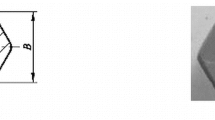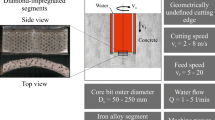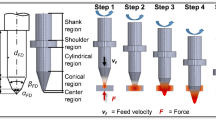Abstract
Galvanized steel is broadly employed in metal roofing, air conditioning duct, support beams, construction materials, and domestic appliances, etc. In conventional drilling method has limitations such as asymmetrical holes, as well as formation of crack inside the hole made in sheet metal. This problem was entirely exterminated in thermal drilling (TD) process. In the course of TD process, the high temperature was developed due to rotational and feed rate of thermal drill into the workpiece. Owing to this reason, the thermal drill pierces workpiece effortlessly. However, in this process, workpiece deformation is very high; therefore, finite-element simulation is used to study the material flow which is challenging in experimental method. According to finite-element method (FEM), the finite-element analysis of TD process was conducted by the DEFORM-3D simulation software. The aim of this study is to conduct an experimental investigation of TD process on galvanized steel (GS), and then, it is compared to numerical results obtained from the FEM. Between experimental and FEM simulation of TD process, a good relationship was found.








Similar content being viewed by others
References
Ozler L, Dogru N (2013) An experimental investigation of hole geometry in friction drilling. Mater Manuf Process 28:470–475. https://doi.org/10.1080/10426914.2012.746699
Ku WL, Hung CL, Lee SM, Chow HM (2011) Optimization in thermal friction drilling for SUS 304 stainless steel. Int J Adv Manuf Tech 53:935–944. https://doi.org/10.1007/s00170-010-2899-5
Hynes NRJ, Kumar R (2017) Process optimization for maximizing bushing length in thermal drilling using integrated ANN-SA approach. J Braz Soc Mech Sci Eng. https://doi.org/10.1007/s40430-017-0820-y
Hynes NRJ, Maheshwaran MV (2016) Numerical analysis on thermal drilling of aluminum metal matrix composite. AIP Conf Proc 1728:1–4. https://doi.org/10.1063/1.4946597
Raju BP, Kumaraswamy M (2012) Finite element simulation of a friction drilling process using deform-3D. Int J Eng Res App 2(6):716–721
Miller SF, Wang H, Li R, Shih AJ (2006) Experimental and numerical analysis of the friction drilling process. J Manuf Sci Eng 128(3):802–810. https://doi.org/10.1115/1.2193554
Miller SF, Shih AJ (2007) Thermo-mechanical finite element modeling of the friction drilling process. J Manuf Sci Eng 129:531–538. https://doi.org/10.1115/1.2716719
Krasauskas P, Kilikevičius S, Česnavičius R, Pačenga D (2014) Experimental analysis and numerical simulation of the stainless AISI 304 steel friction drilling process. Mecha 20(6):590–595. https://doi.org/10.5755/j01.mech.20.6.8664
Bilgin MB, Gok K, Gok A (2015) Three-dimensional finite element model of friction drilling process in hot forming processes. Proc IMechE Part E 231(3):548–554. https://doi.org/10.1177/0954408915614300
Eliseev AA, Fortuna SV, Kolubaev EA, Kalashnikova TA (2017) Microstructure modification of 2024 aluminum alloy produced by friction drilling. Mater Sci Eng A 691:121–125. https://doi.org/10.1016/j.msea.2017.03.040
Miller SF, Blau P, Shih AJ (2005) Micostructural alterations associated with friction drilling of steel, aluminum, and titanium. J Mater Eng Perform 14(5):647–653. https://doi.org/10.1361/105994905X64558
Kim D, Badarinarayan H, Ryu I, Kim JH, Kim C, Okamoto K, Wagoner RH, Chung K (2010) Numerical simulation of friction stir spot welding process for aluminum alloys. Met Mater Int 16(2):323–332. https://doi.org/10.1007/s12540-010-0425-9
Zinati RF, Razfar MR (2015) Finite element simulation and experimental investigation of friction stir processing of polyamide 6. Proc IMechE Part B 229(12):2205–2215. https://doi.org/10.1177/0954405414546705
Pashazadeh H, Masoumi A, Teimournezhad J (2013) A study on material flow pattern in friction stir welding using finite element method. Proc IMechE Part B 227(10):1453–1466. https://doi.org/10.1177/0954405413485952
Baek SW, Choi DH, Lee CY, Ahn BW, Yeon YM, Song K, Jung SB (2010) Microstructure and mechanical properties of friction stir spot welded galvanized steel. Mater Trans 51(5):1044–1050. https://doi.org/10.2320/matertrans.M2009337
Viňáš J, Kaščák L, Greš M (2016) Optimization of resistance spot welding parameters for microalloyed steel sheets. Open Eng 6:504–510. https://doi.org/10.1515/eng-2016-0069
Mazzaferro CCP, Rosendo TS, Tier MAD, Mazzaferro JAE, Santos JFD, Strohaecker TR (2015) Microstructural and mechanical observations of a galvanized trip steel after friction stir spot welding. Mater Manuf Process 30(9):1090–1103. https://doi.org/10.1080/10426914.2015.1004699
Author information
Authors and Affiliations
Corresponding author
Additional information
Technical Editor: Márcio Bacci da Silva.
Rights and permissions
About this article
Cite this article
Kumar, R., Hynes, N.R.J. Finite-element simulation and validation of material flow in thermal drilling process. J Braz. Soc. Mech. Sci. Eng. 40, 162 (2018). https://doi.org/10.1007/s40430-018-1091-y
Received:
Accepted:
Published:
DOI: https://doi.org/10.1007/s40430-018-1091-y




